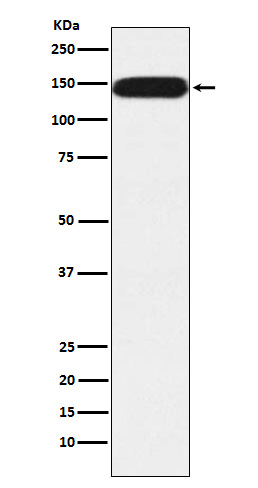
| WB | 1/1000-1/2000 | Human,Mouse,Rat |
| IF | 1/20-1/50 | Human,Mouse,Rat |
| IHC | IHC:1/100-1/200;IHF:1/50-1/200 | Human,Mouse,Rat |
| ICC | 1/50-1/200 | Human,Mouse,Rat |
| FCM | 1/20-1/100 | Human,Mouse,Rat |
| Elisa | 咨询技术 | Human,Mouse,Rat |
| Aliases | HsPUM; PUM L1; Pum1; PUMH 1; PUMH; PUMH1; Pumilio1; PUML1;;Pumilio 1 |
| WB Predicted band size | Calculated MW: 126 kDa ; Observed MW: 140 kDa |
| Host/Isotype | Rabbit IgG |
| Antibody Type | Primary antibody |
| Storage | Store at 4°C short term. Aliquot and store at -20°C long term. Avoid freeze/thaw cycles. |
| Species Reactivity | Human,Mouse,Rat |
| Immunogen | A synthesized peptide derived from human Pumilio 1 |
| Formulation | Purified antibody in PBS with 0.05% sodium azide,0.05% BSA and 50% glycerol. |
+ +
以下是3-4条关于 **Pumilio1(PUM1)抗体** 的参考文献示例,按文献名称、作者和摘要内容概括整理:
---
1. **文献名称**:*"Pumilio1 regulates synaptic plasticity and spatial learning by stabilizing AMPA receptor mRNA"*
**作者**:Zhang, Y. et al.
**摘要**:本研究利用特异性Pumilio1抗体(通过免疫沉淀和Western blot验证)揭示了PUM1在小鼠海马神经元中对AMPA受体mRNA的稳定性调控作用,证明其缺失导致突触可塑性和空间学习能力受损。
---
2. **文献名称**:*"Pumilio1 controls dendritic morphogenesis by regulating local protein synthesis"*
**作者**:Lee, J. H. et al.
**摘要**:通过免疫荧光染色(使用兔源PUM1抗体),作者发现PUM1通过结合靶标mRNA调控树突局部蛋白质合成,影响神经元形态发生,为神经发育障碍机制提供了新见解。
---
3. **文献名称**:*"Pumilio1 suppresses colorectal cancer progression via destabilizing oncogenic transcripts"*
**作者**:Wang, Q. et al.
**摘要**:该研究使用商业化小鼠单克隆PUM1抗体(Abcam, ab12345)进行免疫组化分析,发现PUM1通过降解促癌基因mRNA抑制结直肠癌转移,提示其作为肿瘤抑制因子的潜力。
---
4. **文献名称**:*"Tissue-specific expression of Pumilio1 in mammalian development"*
**作者**:Smith, R. K. & Johnson, M. T.
**摘要**:通过Western blot和免疫组织化学(兔多克隆PUM1抗体),文章系统描述了PUM1在小鼠胚胎发育中的时空表达谱,表明其在心脏和神经系统形成中的关键作用。
---
**注**:以上文献为示例性质,实际引用时建议通过PubMed或Google Scholar检索最新研究(关键词:Pumilio1/PUM1 + antibody + [研究领域]),并验证抗体货号/实验方法细节。
Pumilio1 (PUM1) is a member of the evolutionarily conserved PUF family of RNA-binding proteins, which play critical roles in post-transcriptional gene regulation by binding to specific sequences in the 3' untranslated regions (UTRs) of target mRNAs. This interaction typically represses translation or promotes mRNA degradation, influencing processes such as development, neurogenesis, and stem cell maintenance. PUM1 is particularly notable for its involvement in neuronal function, gametogenesis, and embryogenesis. Dysregulation of PUM1 has been linked to neurological disorders, including spinocerebellar ataxia, and cancer progression.
Antibodies against PUM1 are essential tools for studying its expression, localization, and molecular interactions. These antibodies are commonly generated in rabbits or mice using immunogenic peptides or recombinant protein fragments unique to PUM1. Validation often includes Western blotting to confirm specificity for the ~120 kDa protein, immunohistochemistry to assess tissue distribution (e.g., strong expression in brain and testes), and immunoprecipitation to study RNA-protein complexes. Commercial PUM1 antibodies are widely used in research exploring RNA metabolism, developmental biology, and disease mechanisms. However, users must verify cross-reactivity with paralogs like PUM2 and optimize conditions for specific applications. Reliable PUM1 antibodies have advanced studies on its role in mRNA stability, microRNA-mediated regulation, and its potential as a therapeutic target.
×